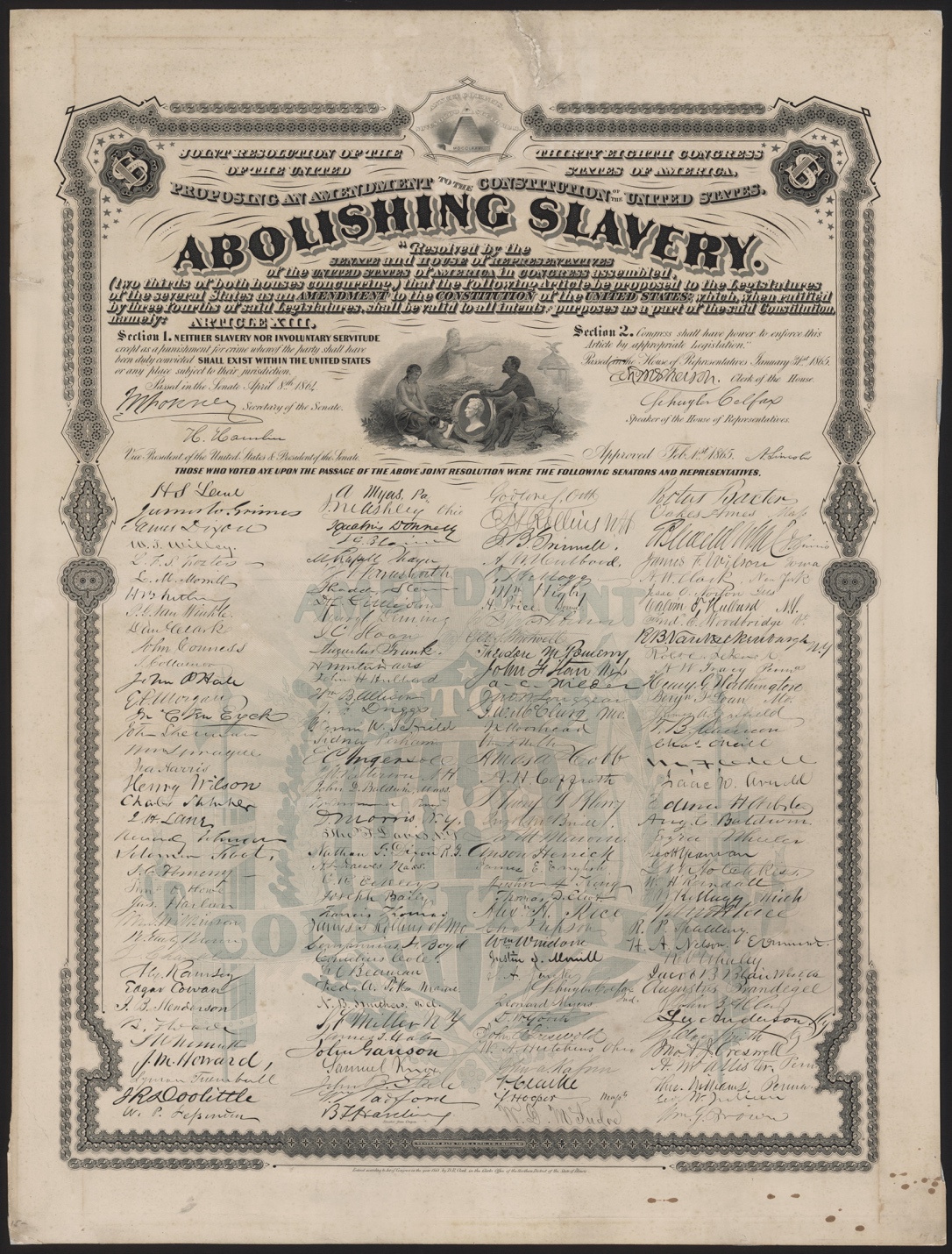Thirteenth Amendment Primary Source
This case study on the Thirteenth Amendment includes an essay, primary sources, analysis questions, discussion prompts, and additional resources.
Thirteenth Amendment | Primary Source
Objectives
- I can explain the meaning and purpose of the Thirteenth Amendment in my own words.
- I can interpret a historical document and image to understand the significance of ending slavery in the United States.
- I can make connections between the text, the image, and the historical context of the amendment.
Directions: Read the text of the Thirteenth Amendment and explore the image that includes the text, art, and signatures. Answer the analysis questions.
Background Information
After the Civil War, the United States faced the monumental challenge of addressing the status of nearly 4 million freed African Americans. To bring a permanent end to slavery, Congress passed the Thirteenth Amendment. This amendment, ratified in 1865, formally abolished slavery and involuntary servitude in the United States, except as punishment for a crime. It marked a crucial turning point in American history, laying the foundation for subsequent efforts to secure civil rights for African Americans.
Thirteenth Amendment, U.S. Constitution, 1865
| Text | Vocabulary and Context |
| SECTION 1.
Neither slavery nor involuntary servitude, |
involuntary servitude- Forced labor or service that a person must perform against their will, except as punishment for a crime. |
| except as a punishment for crime whereof the party shall have been duly convicted, | whereof- of which
duly convicted- Officially found guilty of a crime in a fair and legal trial. |
| shall exist within the United States, or any place subject to their jurisdiction. | jurisdiction- The area where a government or court has power to make and enforce laws. |
| SECTION 2.
Congress shall have power to enforce this article by appropriate legislation. |
Congress has the authority to create laws to make sure the rules in the 13th Amendment are followed. |
Analysis Questions
- What does “neither slavery nor involuntary servitude” mean in this context?
- What specific authority does Section 2 grant to Congress, and how does it ensure enforcement of the amendment?
- What immediate legal changes did the Thirteenth Amendment introduce within the United States?
- How does the phrase “except as a punishment for crime” qualify the prohibition of slavery and involuntary servitude in the amendment?
Background Information
This is a printed copy of the Joint Resolution of the Thirty-Eighth Congress of the United States. It officially proposed the Thirteenth Amendment to the Constitution, which ended slavery. It was passed by Congress in 1865, near the end of the Civil War.
Abolishing Slavery, 1868
Joint resolution of the Thirty-Eighth Congress of the United States, proposing the constitutional amendment to abolish slavery, accompanied by a list of Congressmen voting in favor. Library of Congress. https://www.loc.gov/resource/lprbscsm.scsm0681/?st=image&pdfPage=2
Analysis Questions
Title and Purpose:
- Look at the bold words: “Abolishing Slavery.”
- What do you think this document is about?
- Why was it so important to write this as an official record?
Signatures:
- Look at all these signatures. These are the names of Congressmen who voted “yes” to abolish slavery.
- Why do you think their signatures were included?
- What would it feel like to put your name on something this historic?
The Portrait in the Center:
- Can you see Abraham Lincoln’s picture? Lincoln was president during the Civil War and signed the Emancipation Proclamation in 1863.
- Why do you think Lincoln’s portrait is included here?
- How do symbols like portraits make a document feel more meaningful?
